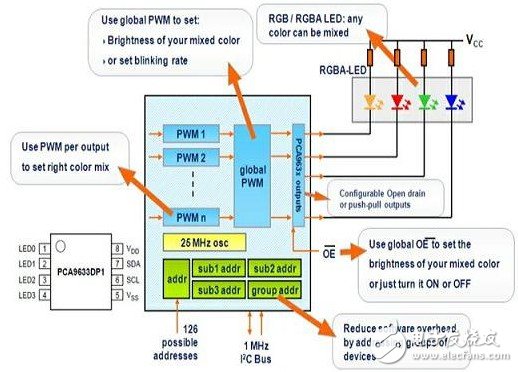Led is undoubtedly one of the hottest applications at present, whether it is handheld devices, game consoles, neon lights, billboards, etc., the dazzling colors and high-quality light can always attract people's attention. In front of many LED controllers, how to choose a product with rich functions and high cost performance to cater to your own design is undoubtedly a problem in front of each designer.
The simplest LED driver, we can use ordinary I / O to achieve. However, I / O control can only realize the ON and OFF of the LED, and can not be used for light mixing, blinking and other functions, and each LED needs to occupy a separate I / O resource, which is undoubtedly very low cost performance. We can also use a dedicated high-current LED controller to design, but the expensive cost will first become a problem, and the design is complicated, the degree will also increase correspondingly with the appearance of various interference. Based on these, NXP launched a series of LED drivers using I2C interface, which can control the ON / OFF, blinking and RGB mixed light of 4 to 24 LEDs ranging from 4 to 24 through two lines of I2C interface. . In the light mixing scheme, each LED is driven by an independent 8bit / 256 order PWM. At present, the current range of each LED that can be driven by the chip itself is between 25mA and 100mA. Of course, for some high current applications, we only need to use the field effect tube to achieve.
This I2C-based LED control method increases the convenience and flexibility of the design, and also reduces the investment in hardware and software, so that the mysterious LED suddenly seems simple and wonderful to us. In the following, we will take the NXP LED driver PCA9633 as an example to fully explain the advantages of this LED driver through a few simple applications.
PCA9633 is a four-way LED driver, and each can drive a maximum of 25mA current, and provides an optional fixed I2C address and a 4-bit or 7-bit hardware programmable hardware address depending on the package (Figure 1).

Figure 1: PCA9633 pin and internal structure diagram
From Figure 1, we can see that each LED is controlled by a single 8bit / 256-level PWM, and because PWM is fast enough, it can theoretically mix any color through the four LEDs it drives. Light. In addition to each individual PWM, PCA9633 also provides a Group PWM, through which we can be used to control the brightness and frequency of the mixed color light, to make up for some functions that can not be achieved by only adjusting a single PWM. So how does PCA9633 achieve dimming? The secret is still in PWM. If PWM is not used, it can only complete the on and off actions; low-speed PWM can only achieve LED blinking, which is not enough to achieve the purpose of color mixing; high-speed PWM can achieve RGB color mixing; Can achieve dual functions of flashing and color mixing. And through the controllable 8bit / 256-level PWM, the color scale is increased to enhance the sense of color (see Figure 2).

Figure 2: Principle of color mixing (click on the picture to see the clear picture)
Knowing the principle of color mixing, how does a specific color come about? We know that the human eye's perception of color is a superposition of the average brightness of various colors. We can control the brightness of the driven LED by controlling the duty cycle of each PWM of PCA9633. According to the principle of three primary colors, if we are driving RGB (or RGBA) LEDs, then by adjusting the different brightness of these three LEDs, we can get the desired color. Figure 3 is an example of PCA9633 controlling three RGB LEDs to adjust pink light.

Figure 3: PCA9633 controls three RGB LEDs to adjust pink light
Home and indoor or building air filters remove unwanted particles like dust, pollen, pet dander and mold and ensure even the most allergy prone can breathe easily year–round. However, choosing the right filter for your home can be a rather involved process. To help, here are the most common indoor air filters and what each of them provides. The filters are the simplest basic component for air filtration solution through your heating and cooling system ,It is important that you constantly monitor the buildup of debris on these filters as well because it can easily be recycled into the air supply. It is easy change and maintain.
Indoor Air Purification Filter & Air purifier filter
AC Filter,Air Conditioner Filter,AC Furnace Filter,Home AC Filter
Donguan Bronco Filter Co., Ltd , https://www.broncofilter-cn.com